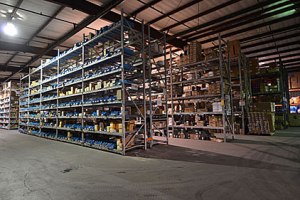
|
| Photo courtesy of Coburn Supply |
America’s amazing outburst as the potential global energy leader already is becoming the surprising success story in an otherwise drab economic scenario.
While the evolving hydraulic fracturing technology justifiably deserves much of the credit for this unexpected surge, what has been given little credit is the nation’s distribution system, unmatched by any of the world’s other major producers of natural resources or manufactured goods.
What is little-known about or transcribed in the media is the nation’s exceptional industrial distribution wholesale network that provides the nation’s turnkey constructors, end users, original equipment manufacturers and retailers with ongoing service and specific product groups to meet the needs of new projects, as well as maintenance and constant consumer demand.
This wholesaler terminus of the marketing channel reflects tens of thousands of small business operators who cover national regions (in the case of some of the largest wholesalers) or service small geographic districts as is the case with smaller, local distributors. The vast majority are privately owned and operated, many on a multigenerational basis. The U.S. distribution network not only provides the focal point in the marketing channel between manufacturers and their ultimate customers, but represents the major purchasing factor between such producers and eventual users, installers and buyers.
Unlike such multinational conglomerates as GE, the automotive giants or the many other multibillion-dollar industrial concerns presiding over a large variety of product categories, the vast majority of independent manufacturers cannot afford to set up independent warehouse systems, field sales groups or finance the massive inventories necessary to eventually gravitate to the ultimate user.
That is why the great majority of these independent manufacturers also utilize commissioned manufacturers representatives to call on America’s vast network of independent distributors that utilize compatible end-use-specific products. With such independent setups, medium-sized or small manufacturers by the tens of thousands are able to transmit multibillion dollars-worth of business, something unsustainable without such a national network.
These networking marketing channels also have encouraged the entrepreneurial innovation of not only ideas and new products, but have continued to dominate a significant part of the nation’s all-encompassing marketing infrastructure. By functioning as independents, they are able to operate as owners and operators.
This allows America’s incomparable, overpowering and complex industrial/economic superstructure to have both publicly-held giant corporations and hundreds of thousands of independent businesses operating in a relatively healthy atmosphere of economic freedom; at least enough so it, by far, outshines similar economic systems existing anywhere else in the world.
Superior economic staying power
As an unabashed admirer of America’s so-called small-business economic core strength, I believe the ability of these independent enterprises, whether manufacturers, distributors, contractors, retailers or architect/engineers, etc., to generate entrepreneurial drive is what’s keeping the U.S. economy functioning better than anywhere else in the world.
The fact that the world’s dominant financial powers still view the U.S. as the prime target for their fixed and liquid asset investment is proof positive of their long-term confidence in the U.S. The most credible example is the outstanding size of the world’s surplus invested in the U.S. Treasury’s growing debt paper positions — one of the reasons the outstanding 10-year note still is projecting a high price and low yield. With the U.S. Federal Reserve Board and foreign investors pouring multi-daily billions into the purchase of notes and bonds all along the yield curve, the Fed’s policies of keeping interest rates down are well-secured.
Further buttressing the solidity of America’s business/industry, financial institutions and the nation’s general fiscal condition is that the U.S. is exhibiting extraordinary financial strength at a time of continuing high unemployment. The combination of the aforementioned factors is reinforced by hundreds of thousands of small businesses sitting on mountains of cash not being utilized for expansion, new acquisitions or additional product lines.
The hold-back on hiring by the independent business sector, which traditionally employs 80% of the nation’s potential jobs pool, primarily is responsible for the unusually high national unemployment level. This appears to be out of sync with the overall 2.5% growth level currently being experienced during the post-recessionary recovery. It must be remembered that despite 25 to 30 million people not currently being employed in full-time roles, a large percentage of the 160 million full-time worker potential is generating the bulk of the producer and consumer demand keeping the U.S. economy at a better-than-expected level as it passes the halfway point of the 2013 calendar year.
Much of today’s “structural” unemployment is caused by the technological boom on the shop floor and back offices, which is making hands-on jobs in many business/industry sectors obsolete. Unquestionably, the highly-accelerated entitlement expansion has supported the consumer buying power that has kept the overall demand level in positive territory while adding to the record national debt.
Also, the apparently more benign Obama administration’s position on energy development is generating a disproportionately
significant level of revenues and employment in states such as Texas, North Dakota, Alaska, West Virginia and Pennsylvania, which have been given the green light of “full-bore” expansion. Lately, the administration has been effective at keeping excessive EPA restrictions at bay by delaying actions.
To realistically view America’s economic future, the categorizing of each of the 50 states by their approach to economic growth and tax abatement, as well as overall business-friendly direction becomes a more realistic method of analyzing forthcoming potential.
Texas/California economic extremes
When evaluating the economic success of the nation’s most populous state (California) and its runner-up (Texas), it’s readily apparent each represents a totally different outlook as to what economic policies should be driving their future. This is represented by their views regarding political leadership, natural resources, environmental approach and the overall interpretation as to what these two states consider best opens the door to America’s future development.
Within the scope of America’s evolving political system, how each state’s dominant governors and/or legislatures view their beckoning opportunities becomes the critical mass of their economic status. An enunciation of their current policies and the results they are or are not achieving is the best way to answer that question. Since both are blessed with America’s greatest concentration of natural resources, their disparate approach to capitalizing on this potential wealth goes a long way toward comparison of current achievement:
1.From 2000 through 2005, both Texas and California were relatively steady in monthly crude oil production. Texas has since doubled its output to 35 million monthly barrels, while California has continued to taper off at a slowly declining 20 million barrels-per-month level. This has Texas producing as much oil as the four next largest producing states combined. Out of a total U.S. production of seven million-plus barrels of oil per day, Texas is producing two million barrels per day and growing.
2.The Golden State, which once was one of the top three oil producers, is now running behind Alaska and the “Bakken Belt” shale-driven North Dakota “miracle.” This has rewarded Texas not only with massive additional revenues and 400,000 additional employees in oil and natural gas, but has put it in a position of generating $80 billion a year in economic activity, which exceeds the annual output of all goods and services in 13 combined individual states. Needless to say, Texas, along with Florida and Arizona, needs no state tax to cover “growing deficits” elsewhere.
3.California comes close to representing the diametric opposite. With the extremist California Air Resources Board dominating state policy executed by its compliant governor Jerry Brown and a state assembly and Senate overwhelmingly controlled by Democrats, not only is California’s Monterey shale the nation’s potentially most productive, but according to knowledgeable geologists it retains huge reserves which are among the most oil-laden off America’s coasts. Ultra-liberal federal judges have supported California’s anti-energy development influence, blocking Occidental Petroleum from tapping into Monterey’s anticipated 15 billion barrel, private land expectation.
This perverse antithesis to Texas’ phenomenal success has left California with the most confiscatory top bracket in the U.S., paid annually with an upfront state tax. However, the state has begun to witness an exodus of wealthy private citizens and a growing number of businesses alike.
U.S. industrial growth potential surges
Why is it that the leading global investment focus currently is on the U.S.? Is it also a coincidence that the U.S. industrial sector, including high tech and exports, is surging? Even the turbulent U.S. stock market has been setting records with basic industrial and technology fabricators well into the mix. The emerging scenario, despite the government deterrent of out-of-control debt and deficit, shows the U.S. becoming the world’s optimum center of potential economic growth. This is being confirmed by the following factors:
1.The evolution of hydraulic fracturing (fracking) has put an estimated value of $100 trillion on America’s fossil-fuel potential (coal, oil, natural gas). Added to the household capitalization assets of the nation’s estimated $60 trillion, this makes the U.S. truly the richest country on earth. When adding America’s ability to top the world in finished goods conversion, no other world nation comes close. This is reflected by Amercia’s annual $16 trillion gross domestic product doubling that of runner-up China.
2.While China’s labor costs and upcoming pollution problems have hindered that nation’s spectacular 25-year growth, the U.S. is becoming increasingly competitive. In addition, “Made in USA” has become the most coveted brand-name identification, denoting top quality, salability and service. No one comes close to the U.S. in the transparency of its values as projected in its publicly-held equities.
3.In the breadth and depth of its technological evolution, the U.S. not only has retained its leadership in creative idea development, but has become the magnet of education in the relevant studies, attracting students from all over the world to its learning centers.
4.Although the American nation has been beset by inflating entitlements and immigration problems, the U.S. is the only Western nation that maintains its population growth at a level to sustain a relatively youthful employment system. This supports the arduous funding necessary to maintain its production system’s viability.
While political self-flagellation has undermined the American population’s self-confidence, the U.S. economy maintains superior monetary liquidity and moderate growth, despite econo-political headwinds. Most remarkable about America’s current economic status is its success in reaching a diversity of leading sectors (manufacturing, exports, agriculture, natural resources and great technological leadership) never before consummated by any other world empire. This is true in post-industrial revolution history, as well as today’s panoply of global competition, emphasized by China, Japan and Germany; or even the second tier of Brazil, Russia and India.
While political leadership, which controls the nation’s taxing and regulatory power, has proven inadequate in directing the American nation’s awesome wealth, the U.S. has proven diverse enough to move strongly forward; this despite government obstacles that are slowing down, but not stopping the forward motion of this awesome and growing global economic powerhouse.


